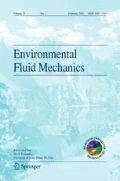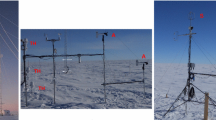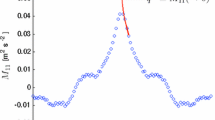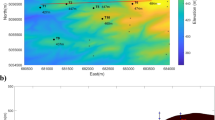Abstract
Over the past decades, researchers have made significant progress toward a fundamental understanding of the budgets of turbulence variables over flat and homogeneous terrain, and only more recently over complex terrain. However, temperature variance budgets, which are parameterized in most meteorological models, are still poorly understood even under relatively idealized conditions. The objective of this study is to analyze the near-surface potential temperature variance budget over contrasting surfaces. To do this, we rely on profiles of near-surface turbulence variables collected as part of the Mountain Terrain Atmospheric Modeling and Observations program. Daytime observations collected in May 2013 in western Utah at three field sites subjected to similar large-scale forcing are analyzed: a desert playa (i.e., dry lakebed), characterized by a flat surface devoid of vegetation; a vegetated site, characterized by a flat valley floor covered with greasewood vegetation, and a slope site with a local slope angle of 2°–4° and covered by 1-m tall sparse desert steppe vegetation. The observations indicate a persistent 5-m surface layer across all three sites, where the flow is equilibrium due to the balance between dominant production and dissipation terms in the potential temperature variance equation. The temperature variances in this layer are well predicted by Monin–Obukhov similarity theory. During convective periods at the Playa and Slope sites, \(\approx 60\%\) of the data show a ratio of turbulent transport to production greater than 0.1. Within the surface layer, turbulent transport of potential temperature variance acts as a sink term at all three sites. Neither the ratio of turbulent transport to production nor the ratio of production to dissipation show a dependence on atmospheric stability during the unstable periods studied. A short-period comparison of dissipation rates calculated using dissipation-scale resolving cold-wire anemometry and several common indirect methods using sonic anemometry is presented for data acquired at Playa site. The results indicate that the dissipation rates from all methods follow similar trends, however the values can differ by a factor of 2–3.














Similar content being viewed by others
References
Abdella K, McFarlane N (1997) A new second-order turbulence closure scheme for the planetary boundary layer. J Atmos Sci 54(14):1850–1867
Albertson JD, Parlange MB, Katul GG, Chu CR, Stricker H, Tyler S (1995) Sensible heat flux from arid regions: a simple flux-variance method. Water Resour Res 31(4):969–973
Albertson JD, Parlange MB, Kiely G, Eichinger WE (1997) The average dissipation rate of turbulent kinetic energy in the neutral and unstable atmospheric surface layer. J Geophys Res Atmos 102(D12):13423–13432
Antonia RA, Chambers AJ, Phong-Anant D, Rajagopalan S (1979) Properties of spatial temperature derivatives in the atmospheric surface layer. Bound Layer Meteorol 17(1):101–118
Antonia RA, Chambers AJ, Friehe CA (1980) Note on the viscous heating term in the temperature variance equation. Bound Layer Meteorol 19(3):269–272
Antonia RA, Browne LWB, Chambers AJ, Rajagopalan S (1983) Budget of the temperature variance in a turbulent plane jet. Int J Heat Mass Transf 26(1):41–48
Arwatz G, Bahri C, Smits AJ, Hultmark M (2013) Dynamic calibration and modeling of a cold wire for temperature measurement. Meas Sci Technol 24(12):125–301
Asanuma J, Brutsaert W (1999) Turbulence variance characteristics of temperature and humidity in the unstable atmospheric surface layer above a variable pine forest. Water Resour Res 35(2):515–521
Bradley EF, Antonia RA, Chambers AJ (1981) Temperature structure in the atmospheric surface layer. Bound Layer Meteorol 20(3):275–292
Caughey SJ, Wyngaard JC (1979) The turbulence kinetic energy budget in convective conditions. Q J R Meteorol Soc 105:231–239
Champagne F, Friehe C (1977) Flux measurements, flux estimation techniques, and fine-scale turbulence measurements in the unstable surface layer over land. J Atmos Sci 34(3):515–530
Chapra SC, Canale RP (1998) Numerical methods for engineers, vol 2. McGraw-Hill, New York
Coantic M, Simonin O (1984) Radiative effects on turbulent spectra and budgets in the planetary boundary layer. J Atmos Sci 41(17):2629–2651
De Wekker S, Liu Y, Knievel J, Pal S, Emmitt G (2013) Observations and simulations of the wind structure in the boundary layer around an isolated mountain during the materhorn field experiment. In: AGU Fall Meeting Abstracts
Deardorff JW (1961) On the direction and divergence of small-scale turbulent heat flux. J Atmos Sci 18(4):540–548
Detto M, Katul G, Mancini M, Montaldo N, Albertson J (2008) Surface heterogeneity and its signature in higher-order scalar similarity relationships. Agric For Meteorol 148(6–7):902–916
Edson J, Fairall C (1998) Similarity relationships in the marine atmospheric surface layer for terms in the TKE and scalar variance budgets. J Atmos Sci 55(13):2311–2328
Fernando HJS, Pardyjak ER, Di Sabatino S, Chow FK, De Wekker SFJ, Hoch SW, Hacker J, Pace JC, Pratt T, Pu Z, Steenburgh WJ, Whiteman CD, Wang Y, Zajic D, Balsley B, Dimitrova R, Emmitt GD, Higgins CW, Hunt JCR, Knievel JC, Lawrence D, Liu Y, Nadeau DF, Kit E, Blomquist BW, Conry P, Coppersmith RS, Creegan E, Felton M, Grachev A, Gunawardena N, Hang C, Hocut CM, Huynh G, Jeglum ME, Jensen D, Kulandaivelu V, Lehner M, Leo LS, Liberzon D, Massey JD, McEnerney K, Pal S, Price T, Sghiatti M, Silver Z, Thompson M, Zhang H, Zsedrovits T (2015) The MATERHORN: unraveling the intricacies of mountain weather. Bull Am Meteorol Soc 96(11):1945–1968
Frenzen P, Vogel CA (1992) The turbulent kinetic energy budget in the atmospheric surface layer: a review and an experimental reexamination in the field. Bound Layer Meteorol 60(1–2):49–76
Grachev AA, Leo LS, Di Sabatino S, Fernando HJS, Pardyjak ER, Fairall CW (2016) Structure of turbulence in katabatic flows below and above the wind-speed maximum. Bound Layer Meteorol 159(3):469–494
Hang C, Nadeau DF, Jensen DD, Hoch SW, Pardyjak ER (2016) Playa soil moisture and evaporation dynamics during the materhorn field program. Bound Layer Meteorol 159(3):521–538
Högström U (1990) Analysis of turbulence structure in the surface layer with a modified similarity formulation for near neutral conditions. J Atmos Sci 47(16):1949–1972
Jensen DD, Nadeau DF, Hoch SW, Pardyjak ER (2016) Observations of near-surface heat-flux and temperature profiles through the early evening transition over contrasting surfaces. Bound Layer Meteorol 159(3):567–587
Jensen DD, Nadeau DF, Hoch SW, Pardyjak ER (2017) The evolution and sensitivity of katabatic flow dynamics to external influences through the evening transition. Q J R Meteorol Soc 143(702):423–438
Kaimal JC, Wyngaard JC, Haugen DA, Coté OR, Izumi Y, Caughey SJ, Readings CJ (1976) Turbulence structure in the convective boundary layer. J Atmos Sci 33(11):2152–2169
Katul G, Goltz SM, Hsieh CI, Cheng Y, Mowry F, Sigmon J (1995) Estimation of surface heat and momentum fluxes using the flux-variance method above uniform and non-uniform terrain. Bound Layer Meteorol 74(3):237–260
Kiely G, Albertson JD, Parlange MB, Eichinger WE (1996) Convective scaling of the average dissipation rate of temperature variance in the atmospheric surface layer. Bound Layer Meteorol 77(3–4):267–284
Kit E, Cherkassky A, Sant T, Fernando H (2010) In situ calibration of hot-film probes using a collocated sonic anemometer: implementation of a neural network. J Atmos Ocean Technol 27:23–41
Kroon L, de Bruin H (1995) The Crau field experiment: turbulent exchange in the surface layer under conditions of strong local advection. J Hydrol 166(3–4):327–351
Lee YH (2009) The influence of local stability on heat and momentum transfer within open canopies. Bound Layer Meteorol 132(3):383–399
Lehner M, Whiteman CD, Hoch SW, Jensen D, Pardyjak ER, Leo LS, Di Sabatino S, Fernando HJS (2015) A case study of the nocturnal boundary layer evolution on a slope at the foot of a desert mountain. J Appl Meteorol Clim 54(4):732–751
Li D, Katul G, Gentine P (2016) The k\(^{-1}\) scaling of air temperature spectra in atmospheric surface layer flows. Q J R Meteorol Soc 142(694):496–505
Lloyd CR, Culf AD, Dolman AJ, Gash JHC (1991) Estimates of sensible heat flux from observations of temperature fluctuations. Bound Layer Meteorol 57(4):311–322
Lumley JL, Panofsky HA (1964) The structure of atmospheric turbulence. Wiley, New York
Mason P, Derbyshire S (1990) Large-eddy simulation of the stably-stratified atmospheric boundary layer. Bound Layer Meteorol 53(1):117–162
Mellor GL, Yamada T (1974) A hierarchy of turbulence closure models for planetary boundary layers. J Atmos Sci 31(7):1791–1806
Mironov DV, Sullivan PP (2016) Second-moment budgets and mixing intensity in the stably stratified atmospheric boundary layer over thermally heterogeneous surfaces. J Atmos Sci 73(1):449–464
Monji N (1972) Budgets of turbulent energy and temperature variance in the transition zone from forced to free convection. Thesis (Ph.D.), University of Washington
Monji N (1973) Budgets of turbulent energy and temperature variance in the transition zone from forced to free convection. J Meteorol Soc Jpn 51(2):133–145
Morrison TJ, Calaf M, Fernando HJS, Price TA, Pardyjak ER (2017) A methodology for computing spatially and temporally varying surface sensible heat flux from thermal imagery. Q J R Meteorol Soc 143(707):2616–2624
Nadeau DF, Pardyjak ER, Higgins CW, Fernando HJS, Parlange MB (2011) A simple model for the afternoon and early evening decay of convective turbulence over different land surfaces. Bound Layer Meteorol 141(2):301–324
Nadeau DF, Pardyjak ER, Higgins CW, Parlange MB (2013) Similarity scaling over a steep alpine slope. Bound Layer Meteorol 147(3):401–419
Nilsson E, Lohou F, Lothon M, Pardyjak E, Mahrt L, Darbieu C (2016) Turbulence kinetic energy budget during the afternoon transition—Part 1: observed surface TKE budget and boundary layer description for 10 intensive observation period days. Atmos Chem Phys 16(14):8849–8872
Obukhov A (1946) Turbulentnost’v temperaturnoj-neodnorodnoj atmosfere. Trudy Inst Theor Geofiz AN SSSR 1:95–115
Obukhov AM (1949) Temperature field structure in a turbulent flow. Izv Akad Nauk SSSR Ser Geogr Geophys 13:58–69
Otić I, Grötzbach G, Wörner M (2005) Analysis and modelling of the temperature variance equation in turbulent natural convection for low-Prandtl-number fluids. J Fluid Mech 525:237–261
Panofsky HA, Dutton J (1984) Atmospheric turbulence: models and methods for engineering applications. Wiley, New York
Plate EJ (1971) Aerodynamic characteristics of atmospheric boundary layers. Technical report, Argonne National Laboratory, Ill. Karlsruhe University (West Germany)
Rife DL, Warner TT, Chen F, Astling EG (2002) Mechanisms for diurnal boundary layer circulations in the great basin desert. Mon Weather Rev 130(4):921–938
Sempreviva AM, Højstrup J (1998) Transport of temperature and humidity variance and covariance in the marine surface layer. Bound Layer Meteorol 87(1986):233–253
Shaw W, Trowbridge JH, Williams AJ (2001) Budgets of turbulent kinetic energy and scalar variance in the continental shelf bottom boundary layer. J Geophys Res Oceans 106:9551–9564
Spade DM (2015) Using the WRF model to simulate the playa breeze over Dugway Proving Ground. The University of Texas at El Paso
Sreenivasan KR, Ra Antonia, Danh HQ (1977) Temperature dissipation fluctuations in a turbulent boundary layer. Phys Fluids 20(8):1238–1249
Tapper N (1991) Evidence for a mesoscale thermal circulation over dry salt lakes. Palaeogeogr Palaeoclimatol Palaeoecol 84(1–4):259–269
Townsend A (1961) Equilibrium layers and wall turbulence. J Fluid Mech 11(1):97–120
Wyngaard J, Coté O (1971) The budgets of turbulent kinetic energy and temperature variance in the atmospheric surface layer. J Atmos Sci 28(2):190–201
Wyngaard JC, Coté OR (1972) Cospectral similarity in the atmospheric surface layer. Q J R Meteorol Soc 98(417):590–603
Wyngaard JC, Coté O, Izumi Y (1972) Local free convection, similarity, and the budgets of shear stress and heat flux. J Atmos Sci 29(6):1230–1231
Yaglom A (1948) Homogeneous and isotropic turbulence in a viscous compressible fluid. Izv Akad Nauk SSSR Ser Geogr i Geofiz 12:501
Zhou T, Ra Antonia (2000) Approximations for turbulent energy and temperature variance dissipation rates in grid turbulence. Phys Fluid 12(2):335–344
Zhu X, Verschoof RA, Bakhuis D, Huisman SG, Verzicco R, Sun C, Lohse D (2018) Wall roughness induces asymptotic ultimate turbulence. Nat Phys 14(4):417
Acknowledgements
This research was funded by the Office of Naval Research Award \(\#\)N00014-11-1-0709, Mountain Terrain Atmospheric Modeling and Observations (MATERHORN) Program. The authors would like to thank Vigneshwaran Kulandaivelu for operating the hot-wire and cold-wire experiment and collecting the data during the field campaign. The authors are also grateful to Sebastian Hoch for providing the radiative fluxes data and the other members of the MATERHORN team that made it possible to collect these data.
Author information
Authors and Affiliations
Corresponding author
Rights and permissions
About this article
Cite this article
Hang, C., Nadeau, D.F., Pardyjak, E.R. et al. A comparison of near-surface potential temperature variance budgets for unstable atmospheric flows with contrasting vegetation cover flat surfaces and a gentle slope. Environ Fluid Mech 20, 1251–1279 (2020). https://doi.org/10.1007/s10652-018-9647-z
Received:
Accepted:
Published:
Issue Date:
DOI: https://doi.org/10.1007/s10652-018-9647-z




